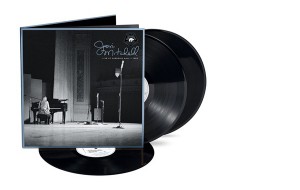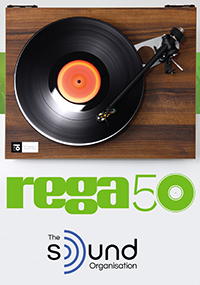posted: April 28, 2022
Joni Mitchell: Live at Carnegie Hall – 1969 Live at Carnegie Hall, 1969

When I was a little kid, I remember listening to albums from my parent’s collection that that have stuck with me throughout the ups and downs of life.
Throughout her career as a songwriter, painter and musician, Joni Mitchell has never made any excuses about being a strong Canadian woman, expressing herself in her art and music. Perhaps those memories of Clouds on that 60’s record player help me enjoy and appreciate The Hissing of Summer Lawns even more today. Mitchell’s Blue and Ladies of the Canyon are two of my favorite late night headphone listening albums – I’ll never shy away from that emotional journey. Her unique voice, distinct guitar sound are never far from my turntable.
The 3 album box set of Joni Mitchell’s career-changing debut at Carnegie Hall saw its first-ever release late in 2021 and I was fortunate enough to land the 180-gram, three LP, snow white vinyl version. This jewel is a must have for dedicated Joni fans.
From the first time you hold the beautiful but heavy jacket, to immersion in the music, Live at Carnegie Hall’ captures a time and place in history. When a 25-year-old Joni Mitchell stepped on stage in her long vintage skirt on February 1, 1969 in front of a packed house, it was her first major concert. Her partner at the time, Graham Nash sat in the audience along with her parents and Bob Dylan. Her debut album, Song to a Seagull had been released less than a year prior, produced by David Crosby. This Canadian was new to California, but familiar with performing at coffee houses and nightclubs. But this was big.
The black and white photo on the cover features Mitchell, pin-straight hair down her back, sitting at a Steinway, 3 mic stands, and her trademark Martin D-28 Dreadnought laying on an otherwise empty stage. If a picture could tell a story, this one certainly sets the tone for what a treasure that jacket holds, captured on vinyl. Joel Bernstein’s candid photographs, Mitchell’s handwritten changes to the set list and lyrics to Blue Boy offer a glimpse into that night in New York.
For first play, this gorgeous white vinyl went onto my reference Acoustic Solid Vintage Exclusive with a low-output Dynavector DV-20X2 cartridge. The album begins with an appreciative crowd and Mitchell opening the 19 song concert with “Chelsea Morning.” According to the notes written by Graham Nash, she had started the song, but had to stop.The crowd, in support of the important event they were witnessing, gave her a Valentine which she held up, smiling on stage. You can hear the nervousness in her voice as she acknowledges this kind gesture, but the initial hesitancy melts away when she settles into “Cactus Tree.” From that moment on, she sounds relaxed, confident and in her element both in her voice and instruments as she bares her heart and soul on that famous stage. She is almost apologetic for her piano playing but nails it on “Blue Boy.” Her lighthearted banter in between tracks sounds more like a conversation she is having with a small intimate crowd instead of addressing the 3,600 seats in front of her. On side 2, (my personal favorite track) the stellar a Capella rendition of “The Fiddle and The Drum” follows her explanation of what it was like to be a Canadian living in America during this incredibly important time in history.
The second set starts with “Marcie”, a song for a friend. The initial nerves are a distant memory, and her voice confidently holds the listener’s attention. Immersed in the music, Mitchell continues her musical storytelling. Dedicating “Morning Morgantown” to her parents, there is a realization that this young woman, alone on stage, has her friends and family there to support her during her first big show, not a seasoned professional who was accustomed to performing to large crowds. The second set ends with a medley of “The Circle Game, and Little Green.” There is a poignant edge to her description of the latter track as being “about a little girl.” At that time in her career, not much was known about her personal struggle after surrendering her daughter for adoption in 1965. Perhaps only a few people in this crowd knew Mitchell’s longing and heartbreak. As she fluidly shifts between the 2 songs, the emotional connection to her story deepens, drawing your focus to the fusion.
The fifth side contains her encore, starting with “Michael From Mountains,” closing the show with “Urge For Going,” after she retunes her guitar and acknowledges how far it is from Saskatoon to Carnegie Hall. Her delightful fingerpicking on the final track draws the listener in as her voice delicately lifts and swells, describing a Sasketchewan winter.
The vibrato in her voice, the sound of fingers plucking steel strings and the voices of the crowd singing with her on Get Together are clearly heard, even when in the background, reflecting the talent of Bernie Grundman’s mastering. Overall, this live recording is dynamic and well balanced without taking away from the artist alone on stage. The exquisite layers and passion behind the music are attained in this album. From the first play, this peek into music history has quickly become a frequent flyer on my TT.
Live at Carnegie hall, 1969 is a gift from a place in history that needs to be remembered as a time of change and uncertainty. This album not only pulls the listener back to late 60’s free spirit hippy culture that embraced my parents, but draws you in with honest vulnerability and creativity. The special place I have for Joni Mitchell and her music throughout my life, in my collection and in Canadian music history, just grew by leaps and bounds. Two very enthusiastic Canadian thumbs up.
www.jonimitchell.com
–Shanon McKellar











